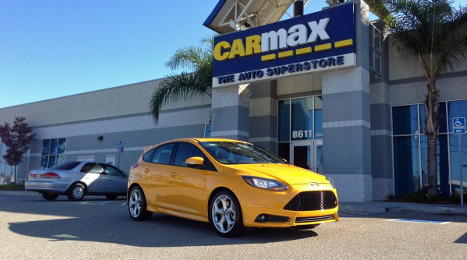CarMax’s Special Subprime Portfolio Nears $30M

As of May 31, CarMax neared $30 million in loans through its special subprime program. (Photo by Edmunds.com)
During the first quarter of its 2015 fiscal year, CarMax Auto Finance originated $20.5 million of loans — representing 0.8 percent of retail unit sales for the timeframe — through its program for customers who typically would be financed by the company’s third-party subprime providers.
As of May 31, the company tabulated that a total of $29.6 million of loans had been originated through its special subprime financing program.
“We’ve always talked about the fact that we want to make sure our customers have access to credit at all kinds of different scales of credit. And if you look at our applicant flow, we’re still at 90 percent of our applicants are getting approval of some kind,” CarMax president and chief executive officer Tom Folliard said during the company’s conference call last week.
Folliard also reported that Q1 income at CarMax Auto Finance increased 8.7 percent to $94.6 million, driven by an increase in average managed receivables, partly offset by a lower total interest margin.
The company’s average managed receivables grew 20.1 percent to $7.39 billion as CarMax Auto Finance total loan originations have grown in recent years, according to the company.
Folliard also pointed out the total interest margin — which reflects the spread between interest and fees charged to consumers and the company’s funding costs — declined to 6.7 percent of average managed receivables in the first quarter from 7.2 percent in the first quarter of the last fiscal year.
Investment analysts wanted to know more details on the impact this subprime program might have on the performance of CarMax Auto Finance.
“At this point it’s little early in the process with the subprime and the expected losses are still high,” CarMax executive vice president and chief financial officer Tom Reedy said. “It’s actually a little bit of a drag on CAF earnings, but it’s nothing material. We have to reserve 12 months of losses out the gate as we originate those loans. And with those loans having a higher expected loss rate than our regular portfolio, until we start building up a critical mass, it’s actually going to be a little bit of a drag on our earnings, but it’s very minimal and nothing to report.
“As we go forward, it may have some impact on the loss provision, our average contract rate and the overall allowance,” Reedy continued. “And to the extent that it does become something that merits calling out, we’ll give you that color.”
Whether it’s through its own program or third-party financing, CarMax executives are seeing some slowdown in the amount of subprime paper that’s going into portfolios connected by vehicles retailed by their company.
“We told you last year at this time that our subprime providers had got a little more aggressive,” Folliard said. “We told you in the third quarter that they had pulled back a little bit. It was 21 percent last year when we thought people would be a little bit more aggressive, and we saw a little pull back. We were flat in the fourth quarter. We’re slightly down in this quarter. It’s not that surprising based on what we have told everybody.
“But in terms of where it comes out long term, it’s not really within our control,” Folliard added.
Later during the conference call, Reedy offered his assessment of subprime financing behavior.
“Subprime penetration is going to be a combination of factors driving it. One is the credit coming through the door, and then another is the behavior of the other lenders in the system,” Reedy said. “Over time we worked to try to build, as Tom mentioned, a broad spectrum of lenders so that customers have access to credit and I think we are very happy with the partners we have today. We’ve got nothing but praise for them.
“You look at cash penetration, it was flat. Subprime was down a little bit. We did see a lift in sales that were funded by sources outside of our system. We did see a lift in sales funded by our Tier 2 partners which means they stepped up and took some customers that they may have declined in the past. So Tier 3 behavior is going to be a combination of what’s coming through the door and what makes it down to them, and finally their behavior and their credit appetite,” Reedy continued.
“Our stores’ ability to convert ones we have approvals to work with and the higher, the better the quality of approval, in other words the lower the down payment, the better chance we have a conversion,” Reedy went on to say. “So I would expect over time those things are going to be constantly moving as lenders continue to tweak their scorecard and make adjustments based on the performance of the portfolio that they have originated.”

 View The Latest Edition
View The Latest Edition

